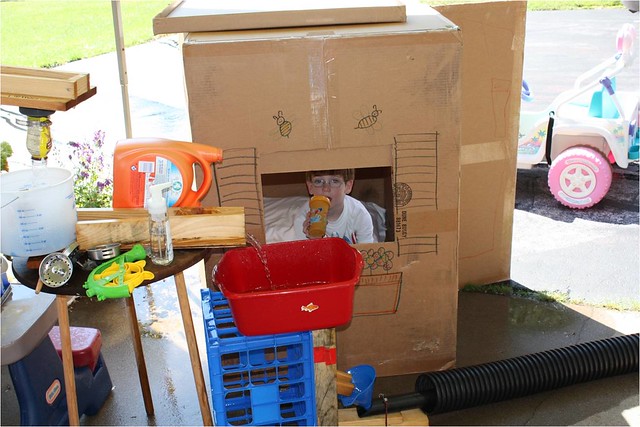Wednesday, November 16, 2011
Out of the Box (More Musings on a Play Therapy Conference)
One of my favorite children's books about creativity is called Not a Box by Antoinette Portis. This hard-cover book feels like a cardboard box. It is a reminder of how easily children can take a simple box and turn it into a variety of objects through their play. I'm sure that many of us have memories of taking old, large appliance boxes or the boxes our toys came in on Christmas morning and turning them into a house, a puppet theater, or a car.
This simple message was also clear to me at the APT play therapy conference last month. Charlie Schaefer, Linda Homeyer, and Sueann Kenney-Noziska were the keynote speakers on "Directive or Nondirective: Is That Really the Question?" In the field of play therapy we tend to put theories, techniques, and one another in boxes: nondirective or directive. It's something we as human being naturally do. Our brains are bombarded with so must information that we judge the information and categorize it as a way to get a handle on it and make sense of it given our own beliefs and experiences. Are you Democrat or Republican? Conservative or Liberal? Gay or straight? But there are many downsides to putting people and ideas in boxes.
I resist being categorized because I don't like to judged. When I'm judged I might be judged negatively or found lacking in some way. When you put me in a box you might make assumptions about me that aren't true based on your prior experiences of said box. These misassumptions then prevent us from truly connecting on an authentic level where we value one another as human beings and can learn from each other's varied backgrounds.
This year's APT conference had a different vibe for me. I'm not sure if it's because it seemed to be smaller and more intimate compared to past years. Or was it the physical arrangement of having to walk through the bar and gathering area of the hotel in order to get to the workshops at the conference center across the street? I found myself sitting and talking and laughing and networking with a wide variety of people. Friends old and new. I learned new things about other play therapists that changed how I view them. I may not practice play therapy in the same way that they do and that is okay. Who am I to say that I have THE one right way to believe? And if I take the time to listen to their story and have an open-mind, how can I argue with their experiences?
When one is starting out as a play therapist or in any field, it helps to have "boxes" and categories to aid in understanding and grasping of a lot of information. That is a good thing. Our "boxes" provide a rationale for why we do what we do. Yet, after awhile it can be helpful to have an open-mind, broaden our horizons and get out of the box. For me, this is how I continue to grow as a play therapist and as a human being. In fact, it's a big part of what creativity is all about.
Labels:
book,
creativity,
play,
play therapy
Subscribe to:
Post Comments (Atom)


Great observations, Jodi, especially as we deliberately organized our 2011 Conference to promote member engagement. Although play therapists overtly say they attend for the continuing education credit, they covertly admit that meeting and laughing with colleagues drives their return. It's tough to get members in a "virtual organization" to mix but Leadership Academy has created blocks and introduced them to each other at conferences. All this to say that your observations are spot on and greatly appreciated!
ReplyDeleteI enjoyed your observations, Jodi. To me the changes in the way the conference was laid out are similar to turning a box on its side. It challenges people to crawl out of their box and take a peek inside another box.
ReplyDelete